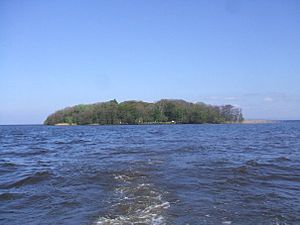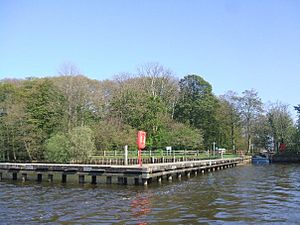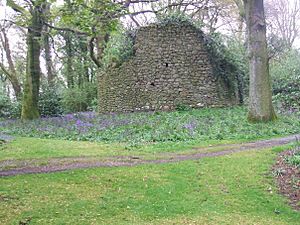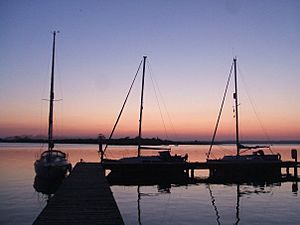Coney Island, Lough Neagh facts for kids
Coney Island is a small island located in Lough Neagh, which is in Northern Ireland. It's about 1 kilometer away from Maghery in County Armagh. The island is covered in trees and is nearly 9 acres (about 3.6 hectares) in size.
You can find Coney Island in the southwest part of Lough Neagh, right between where the River Blackwater and the River Bann flow into the lough. If you want to visit, you can take boat trips to the island on weekends from Maghery Country Park or Kinnego Marina.
The island belongs to the National Trust, which is a charity that looks after special places in the UK. Armagh City, Banbridge and Craigavon Borough Council helps to manage the island for them. Close to Coney Island, there's a rocky area called Coney Island Flat. While Coney Island is the most famous, there are other smaller islands in this part of Lough Neagh too, like Croaghan Island.
Contents
What's in a Name?
Coney Island has had a few different names over time. It was once known as Innisclabhall. Later, it was called Sydney's Island.
A Journey Through Time: Coney Island's History
Coney Island has a very long and interesting history. People have lived on this island for thousands of years!
Ancient Times
Archaeologists dug up parts of the island in the 1960s. They found signs that people lived there during the Neolithic period (the New Stone Age) and the Bronze Age. This means people were here even before written history!
The island was once connected to the mainland by a path or ridge under the water. You can sometimes see this path in summer when the water level is low. Locals call it Saint Patrick's Road. It's said that Saint Patrick, the patron saint of Ireland, used the island as a quiet place to think and pray. In the 1800s, this path was broken to let barges (flat-bottomed boats) travel between the River Bann and the River Blackwater.
Medieval Fort and Lookout
Coney Island also has a special mound from the 1200s called a motte. This was built by the Anglo-Normans, who were people from France and England who settled in Ireland. This motte was one of their most western forts in Ireland.
Later, during the Middle Ages, a local community lived on the island. They even had a small iron-making business there. The island was made stronger with a bank, a ditch, and a wooden fence around it to protect it.
In the 1500s, a powerful Irish chieftain named Shane O'Neill used the island. He had a stone tower there, which he used as a lookout point and a safe place for his treasures. This tower has been rebuilt quite a bit since then. Coney Island was one of O'Neill's main strongholds. However, in 1567, he handed the island over to Sir Henry Sidney, who was a high-ranking official. The island continued to be used as a fort for many years after that. Eventually, the defenses were taken down.
Later Years
In the 1600s and 1700s, people only lived on the island sometimes. Then, in the 1890s, a man named James Alfred Caulfield, who was the 7th Viscount Charlemont, bought Coney Island. He supposedly paid £150 for it! He lived nearby and built a summer house on the island in 1895. The Viscount's remains are actually buried inside the tower on the island.
In 1946, Fred Storey gave the island to the National Trust, so it could be looked after for everyone to enjoy.






